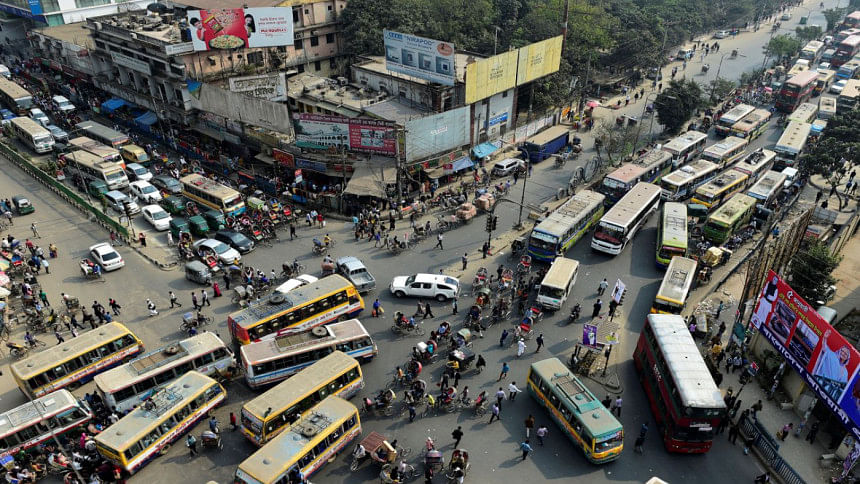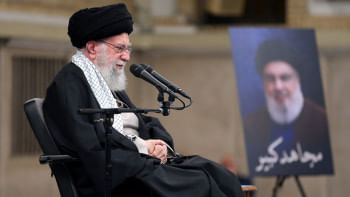Clarity of thought and action for a livable Dhaka

Traffic congestion has become synonymous with dwindling livability and quality of life in Dhaka. 'Livability' has to do with access to basic amenities along with sanitation, clean air and clean water. 'Quality of life' has a wider meaning: security, health, wellbeing, recreation, quest for knowledge, creativity and purposeful life.
But the way the long hours in traffic are encroaching on other pursuits of citizens with stressful after-effects has become the decisive factor of livability and quality of life in Dhaka. This is more so because exhaust fumes from jam-packed traffic cause a great deal of harm to the environment and in turn to public health.
Thus, we have it from a UNESCO source that the number of students going abroad since 2000 more than quadrupled in 2016. "Experts and students…. have all identified the fact that Dhaka's traffic jams are the number one reason for people to leave, who say they spend hours of their lives waiting in traffic," according to a report in an English daily.
The average speed of Dhaka traffic is down to 7km per hour, a trifle above the walking speed. No wonder the traffic devours 3.2 million hours on a daily basis, according to a World Bank estimate. The annual loss to the national economy runs into Tk 30,000 crore. In lost investment, we count another Tk 1 lakh crore going by investment board's calculation.
Sheila Dikshit, the former chief minister of the Indian state of Delhi, on a visit to Dhaka last July shared experiences of her time in office, some of which shed light on traffic management in the Indian capital. She said that she raised the number of flyovers from four to 48 helping ease Delhi's traffic congestion a great deal. We have our flyovers, obviously fewer in number than New Delhi's—the latter is a city of vast distances/spaces that Dhaka is not. She had plenty of options to play with. So what could work for Delhi couldn't have for Dhaka. This is not to say that we couldn't have built the flyovers to a point of collective utility and easement of movement in their service areas and beyond.
It is worth noting that she upheld the principle of consultation. To a question, "How can Dhaka city become more livable through the prevention of pollution and traffic congestion?" Dikshit replied, "My suggestion, as we did in Delhi, is to talk to all sections of people, be it from slums or apartments, to get a clear idea about their priority. Then you have to act upon their choices" (Dhaka Tribune, July 20, 2017).
Where do we go from here so that Dhaka can bounce back? First, we don't waste time crying over spilt milk; we have to make a bold, fresh start. When liveability and meaningful functioning of the city are at stake, an ad hoc or even contingency approach cannot be considered as a substitute for systematic governance.
It is difficult to restructure a 400-year-old Dhaka city but we can build updated satellite cities as per our latest and projected requirements. The land constraint may be obviated by restructuring some existing adjacent district or sub-divisional urban centres as self-contained municipalities. Newer inter-city railway links and circular waterway connectivity, the latter especially in the monsoons, can be thought of and laid out.
We will have to bear in mind several specific core elements in our drive to rejuvenate Dhaka city: mapping accurately all underground utility lines, technically known as ARC GIS, to avert the disruptive off-season road-digging activities; reclamation of natural channels; taking at least 25 percent of the population pressure off Dhaka; reducing the overwhelming occupancy of streets by private cars; putting a stop to escalation of rickshaws; having separate lanes for slow-moving conveyances; and above all, dedicated lanes for buses.
We have at least three mega-projects in hand which on completion would greatly mitigate some of the above concerns. These are: metro rail, elevated express highway and mass rapid transit system. Experts believe that such an infrastructure would straight away ensure that 25 percent of Dhaka's inhabitants live outside of it.
Some ministries may be moved to the adjacent district headquarters, important educational institutions can have second campuses just as autonomous bodies may be dispersed away from Dhaka.
With the soil testing almost done, officials of the metro rail project sounded hopeful as of May 31, 2015, that the first phase could be operated by the end of 2019. The 10km stretch between Uttara and Agargaon would be first launched as part of the 20km line. This will enable crossing from north to south in 36 minutes where currently it takes at least two hours.
With 24 locomotives and 144 coaches it will operate along 16 stations, carrying 60,000 passengers per hour, dramatically reducing, it is hoped, the presence of private cars on the street.
Jica, one of the financiers of the project, at one stage reportedly wanted more engineers on the metro transport company rather than bureaucrats. Three deals have been signed with Chinese and Thai firms too.
The 24km Dhaka-Ashulia Elevated Expressway, approved by Ecnec in October 2017, is scheduled to be completed by 2022. Principally financed by China's Exim Bank but with considerable government investment, it will connect to the four-lane Dhaka-Chittagong highway. Major utility of the project envisages that vehicles from northern districts will not have to face Dhaka traffic on their way to Chittagong.
At an international conference themed "Towards Great Dhaka: Development Options for Dhaka Towards 2035" organised by the World Bank last July, experts completed the circle of focus, as it were. They stressed the importance of planning and implementation of projects for East Dhaka to turn it into a vibrant hub of activity as an antidote to unplanned rapid urbanisation in almost all of the rest of Dhaka.
Shah Husain Imam is adjunct faculty at East West University, a commentator on current affairs and former Associate Editor, The Daily Star.
Email: [email protected]

 For all latest news, follow The Daily Star's Google News channel.
For all latest news, follow The Daily Star's Google News channel. 



Comments